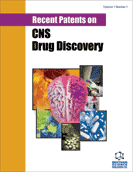Abstract
Gap junctions (GJs) are highly specialized membrane structures which allow the passage of small molecules and ions between neighboring cells. Intercellular communication via GJs is a crucial mechanism that plays a central role in several pathologies. This review focuses on: i) the role of connexins (Cxs, transmembrane proteins that form GJ channels) in the pathophysiology of neuronal injury after brain hypoxia-ischemia, ii) the opposing theories regarding whether Cxs are protective agents or contribute to the spread of damage, and iii) recent patent applications and registrations showing Cxs as key targets in regulating GJ-mediated intercellular communication.
Keywords: Gap junction, connexins, nervous system, neurons, injury, hypoxia, ischemia, knock out, knock down, blockers
Recent Patents on CNS Drug Discovery (Discontinued)
Title: Gap Junctions as Therapeutic Targets in Brain Injury Following Hypoxia- Ischemia
Volume: 3 Issue: 3
Author(s): Macarena Sahores and Ariadna Mendoza-Naranjo
Affiliation:
Keywords: Gap junction, connexins, nervous system, neurons, injury, hypoxia, ischemia, knock out, knock down, blockers
Abstract: Gap junctions (GJs) are highly specialized membrane structures which allow the passage of small molecules and ions between neighboring cells. Intercellular communication via GJs is a crucial mechanism that plays a central role in several pathologies. This review focuses on: i) the role of connexins (Cxs, transmembrane proteins that form GJ channels) in the pathophysiology of neuronal injury after brain hypoxia-ischemia, ii) the opposing theories regarding whether Cxs are protective agents or contribute to the spread of damage, and iii) recent patent applications and registrations showing Cxs as key targets in regulating GJ-mediated intercellular communication.
Export Options
About this article
Cite this article as:
Sahores Macarena and Mendoza-Naranjo Ariadna, Gap Junctions as Therapeutic Targets in Brain Injury Following Hypoxia- Ischemia, Recent Patents on CNS Drug Discovery (Discontinued) 2008; 3 (3) . https://dx.doi.org/10.2174/157488908786242452
| DOI https://dx.doi.org/10.2174/157488908786242452 |
Print ISSN 1574-8898 |
| Publisher Name Bentham Science Publisher |
Online ISSN 2212-3954 |
 3
3Related Articles
-
GLT-1 Upregulation as a Potential Therapeutic Target for Ischemic Brain Injury
Current Pharmaceutical Design Relationship Between Oxidative Stress, Tau Level and Antioxidant Mechanisms of the KEAP-1/NRF-2/HO-1 in Children with Hydrocephalus
Anti-Inflammatory & Anti-Allergy Agents in Medicinal Chemistry An Update on the Roles of the Complement System in Autoimmune Diseases and the Therapeutic Possibilities of Anti-Complement Agents
Current Drug Therapy The Therapeutic Potential of Toll-Like Receptor 7 Stimulation in Asthma
Inflammation & Allergy - Drug Targets (Discontinued) S-nitrosation/Denitrosation in Cardiovascular Pathologies: Facts and Concepts for the Rational Design of S-nitrosothiols
Current Pharmaceutical Design Why and How We Should Treat Elderly Patients with Hypertension?
Current Vascular Pharmacology Conference Report (The XVth International Symposium of Brain Edema and Cellular Injury)
CNS & Neurological Disorders - Drug Targets Sleep-Disordered Breathing and Cardiovascular Disease: Exploring Pathophysiology and Existing Data
Current Respiratory Medicine Reviews New Strategies in the Development of Antidepressants: Towards the Modulation of Neuroplasticity Pathways
Current Pharmaceutical Design Lipoprotein (a) and Cardiovascular Risk: The Show Must go on
Current Medicinal Chemistry Sugars that Glow in the Dark: Fluorescent Tagged Glucose Bioprobes and their Facilitation of the Drug Discovery Process
Current Medicinal Chemistry Editorial [ Proteases and Phospholipases in CNS Disorders Guest Editor: Swapan K. Ray ]
CNS & Neurological Disorders - Drug Targets Delayed Treatment with Nicotinamide Inhibits Brain Energy Depletion,Improves Cerebral Microperfusion, Reduces Brain Infarct Volume, but does not Alter Neurobehavioral Outcome Following Permanent Focal Cerebral Ischemia in Sprague Dawley Rats
Current Neurovascular Research Neurological Involvement in Rheumatoid Arthritis
Current Immunology Reviews (Discontinued) Ambiguities in Neutrophil Extracellular Traps. Ongoing Concepts and Potential Biomarkers for Rheumatoid Arthritis: A Narrative Review
Current Rheumatology Reviews Potential Anti-cancer Drugs Commonly Used for Other Indications
Current Cancer Drug Targets Zebrafish Model in Drug Safety Assessment
Current Pharmaceutical Design Propitious Profile of Peppery Piperine
Current Molecular Pharmacology Branched-Chain Amino Acids and Pigment Epithelium-Derived Factor: Novel Therapeutic Agents for Hepatitis C Virus-Associated Insulin Resistance
Current Medicinal Chemistry Opioids: Old Drugs for Potential New Applications
Current Pharmaceutical Design






















